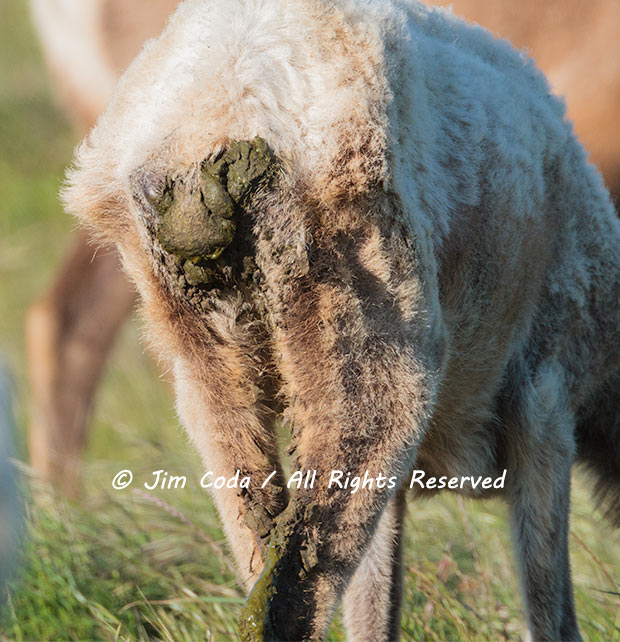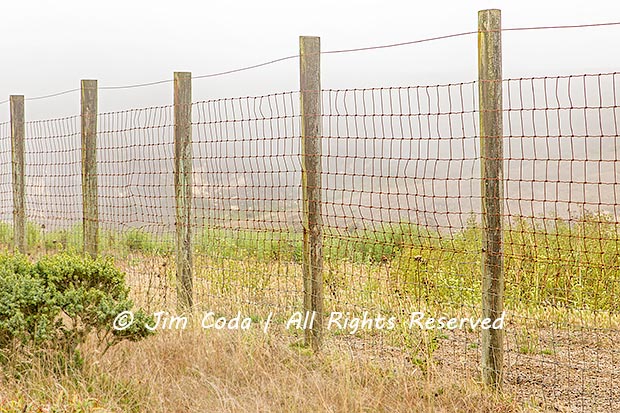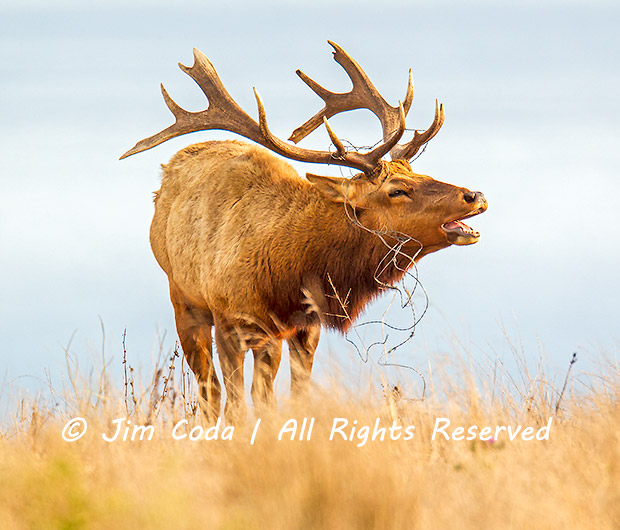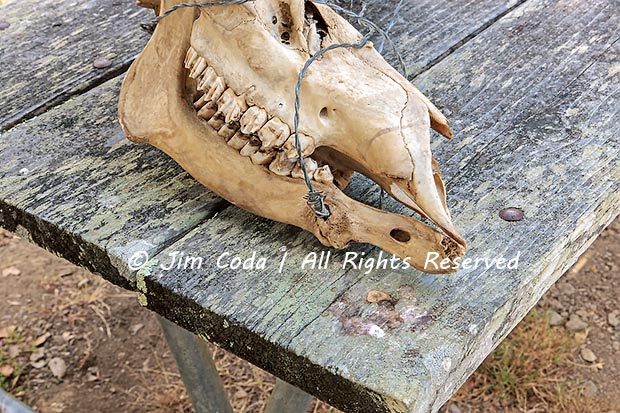Category: Tule Elk
Elk Calf; Point Reyes National Seashore

I was out at Point Reyes yesterday and it was the first time this year I saw elk calves in the elk reserve/enclosure at Tomales Point. I saw elk calves at Drakes Beach about a month ago. The elk in the reserve seem to be about a month behind the Drakes Beach herd in mating and giving birth.
It seemed like there were more cows with calves than I’ve seen in years. If true, it could be because of the heavy winter rains. I’ll be interested in seeing if the elk count shows more calves this year.
I saw this little guy wade into the pond. I watched him for about an hour and I finally left. His mom came to the pond a few times. She called and seemed to want him to follow her, but he ignored her. He roamed all over the pond; drinking water occasionally.
If you look closely you can see a lump on the bridge of his nose. A cyst? I don’t know. Hopefully, it’s nothing serious.
Elk Calves; Point Reyes National Seashore

I’m biased in favor of predators. That’s why when I’m at Point Reyes I’m always looking for bobcats and coyotes. If I’m lucky, maybe I’ll spot a badger. If I’m super lucky, maybe some day I”ll spot a mountain lion. (I keep looking, but they’re not likely to be in the open areas I frequent.)
Anyway, on the last few drives to Point Reyes I’ve thought to myself that it’s that time of year that I ought to look for elk calves and deer fawns. By the time I get there though, I have forgotten about them because of my obsession with predators. Yesterday, I decided I’d better remember to look for them before it’s too late to see them when they are still small. Luckily, there were some along Drakes Beach Road. I also saw two cow elk away from the herd which made me think they may have very young calves hidden nearby. I didn’t see any fawns. Maybe next time.
Point Reyes National Seashore; Some Elk Have Fatal Disease
The current issue of the Point Reyes Light has an article reporting that five of the 200 plus wild, free-roaming elk in the park have been found recently to have Johne’s Disease. Here’s a link to the article: http://www.ptreyeslight.com/article/seashore-finds-elk-gut-disease
Johne’s (pronounced “Yo-nees”) is a bacterial disease that affects the small intestine of ruminants (cows, sheep, elk, deer etc). It is caused by Mycobacterium avium paratuberculosis (“MAP”). It embeds itself in the wall of the lower part of the small intestine. As an immune response, the walls of the small intestine become thicker. This thickening prevents the absorption of nutrients. As a result, the animal loses weight and dies. It is believed to have started in Europe and it is now a world-wide problem. Sixty-eight percent of dairy herds in the United States are infected with MAP. MAP leaves or exits infected animals in feces and milk. It can survive outside a host animal for up to a year. Even if the mother is not infected, her young can acquire it from her teats if they are contaminated with MAP-carrying manure from lying on the ground. Once it is in a herd it is virtually impossible to remove. It spreads easily from one ungulate species to another as from cattle to elk and vice versa. This information was obtained from the following sites: site1, site2.
That some elk tested positive was a big surprise because the park has been sending fecal samples to a lab for about 18 months to determine if there is Johne’s in the two wild, free-roaming Limantour and Drakes Beach herds. Hundreds of samples have been examined and all the results have been negative. That is, until now. According to the article, three elk from the Drakes Beach herd have tested positive via fecal samples. Thirty fecal samples remain to be tested. Furthermore, the park recently killed 20 elk to get tissue samples because tissue samples may be more conclusive than fecal samples. Tissue from a single natural death was added to that. Ten results are in for tissue samples and two of ten bulls from the Drakes Beach herd tested positive. Eleven samples remain to be tested, according to the article.
Johne’s is very slow in its development. It can take years before an animal may look like it might have it. It is very difficult to test for and many results are false negatives. As it progresses the first obvious signs are loss of weight and diarrhea.
Here is a photo of a Tomales Point elk that I took a few years ago. The Tomales elk are not wild, free-roaming. They are captive animals that live on the former Pierce Point Ranch on a peninsula at the extreme north end of the park. I photographed this animal because its ribs were showing, it had severe diarrhea, and I thought it might have had Johne’s Disease. The Tomales Point herd has had Johne’s since about the time the first elk were released on Tomales Point. They may have gotten it from the cattle that were there when the elk arrived.

I wrote a blog about it at the time. Here’s a link to the article: https://jimcoda.wordpress.com/2012/12/15/whats-wrong-with-this-tule-elk-at-point-reyes-national-seashore/
The Point Reyes Light article raises some questions.
It’s too bad the park didn’t wait just a little longer before shooting the 14 Drakes Beach elk, given the fact that the latest fecal samples had three positive results. Fourteen elk could have been spared. In any event, was 14 out of 92 total animals (early 2015 figure) the appropriate number of elk to kill for samples of the Drakes Beach herd? That’s 15%. Maybe. I don’t know. According to the article, the first ten tissue samples were all bulls of the Drakes Beach herd. I’m sure the ranchers were happy that 14 Drakes Beach elk were removed and especially happy that at least 10 were bulls because it’s been my experience that the bulls roam beyond the D Ranch more than the cows. Were 10 (or possibly more) bulls an appropriate number out of about 20 bulls for sampling? That’s roughly 50%. Again, I don’t know, but it seems high. Was six out of 120 total animals (early 2015 figure) the appropriate number of elk for the Limantour herd? That’s only 5%. Again, I don’t know. But since the Limantour herd is a bigger herd, wouldn’t it be logical that you would take more Limantour elk (or less Drakes Beach elk)? Again, the take was not the 15% Drakes Beach take, but only 5%.
The park may have thought it made more sense to focus on the Drakes Beach herd. It is the herd that is the main focus of a ranch management plan that will determine what to do with wild elk. The ranchers want them out of their permit areas. Cal Fish and Wildlife would be much less likely to agree to moving any of them to other elk areas in the State given that it is virtually impossible to guarantee that an individual animal hasn’t got Johne’s if its in a herd that is infected. The park would seem to be left with the choices of shooting some or all which would be highly controversial and/or moving some or all to some other suitable place in the park (which may not exist).
According to the article (and my own research), dairy operations have a high (68%) incidence rate of Johne’s Disease nationwide whereas beef cattle have a relatively low incidence rate (8%). Having animals close together seems to increase the spread of the disease and dairy cows spend much more time in close proximity than beef cattle. A 1979 study of PRNS dairy herds found five out of ten (50%) were positive for Johne’s. I have no information as to how rigorous the 1979 study was. Given how hard it is to detect Johne’s, it could be that 50% was on the low side. It may take several years for it to be obvious and dairy cows are slaughtered at a relatively young age. I don’t believe there is any testing of dairy herds at Point Reyes nowadays. There should be, especially the dairy herds that the elk share grazing land with. Furthermore, dairies not only have a much higher incidence of Johne’s than beef ranches, but they require much more water than beef ranches and they cause more environmental impacts to natural resources, especially water resources. While I find it difficult to understand how the park can justify beef ranching, given that its duty is to protect natural resources first, I don’t see how the park can possibly justify dairy ranching. It has avoided addressing ranching in any form by continuing to ignore its duty to do a General Management Plan for the park.
254 Elk Die of Thirst in Elk Range; Point Reyes National Seashore

The elk in the Tomales Point Tule Elk Reserve (Pierce Point Ranch area) have been dying in large numbers due to lack of water or dehydration. It’s a slow way to die.
The elk population dropped from 540 in 2012 to 357 in 2013. That’s a loss of 183 animals or a 34% die-off. Point Reyes Light, March 6, 2014. Elk numbers declined from 357 to 286 in 2014. That’s a loss of another 71 animals or an additional 20% die-off. Point Reyes Light, March 19, 2015. That’s a total loss of 254 animals or 47% of the elk in two years in the Elk Reserve. Almost half the population. How many will die in 2015?
Meanwhile, the two smaller, wild free-roaming herds located at the south end of the park in the Central and South Units of the Phillip Burton Wilderness (120 elk) and in the “pastoral zone” (92 elk), which lies between the wilderness and the elk reserve, have increased in numbers despite the drought. “The seashore attributes the success of the free-ranging herds to their ability to seek out forage and water at a time of drought.” Id.
The elk in the reserve are not free-ranging like the elk in the rest of the park. They are held captive behind an 8-foot tall woven wire fence. Thus, they can’t seek out water at a time of drought when there isn’t enough water inside the enclosure. The most recent article above quotes park official, Dave Press, as saying: “A lack of rainfall likely contributed to their ongoing struggles.” The article goes on to say that “[s]tock ponds in the fenced area that dried up during the drought have been replenished by rains in the last few months, but the seashore is developing a plan to truck water to an easily accessible pond, if it runs dry again in the future.”

What is the situation regarding water availability in the reserve? Not good. According to the 1998 Tule Elk Management Plan, the situation then was as follows:
There are no natural year-round streams [in the elk reserve] . . . From late spring to late autumn only spring-fed seeps would provide water for elk if it were not for the existence of eight water impoundments originally built for cattle . . . The water impoundments are a factor in determining the ability of the elk range to support its population. While clearly an artificial construction, caution should be taken to ensure that any alteration of artificial water sources does not impact other species of special concern [red-legged frogs]. Otherwise, a return of the elk range to its native condition of seep-fed springs is considered desirable to maintaining viable populations.
Tule Elk Management Plan, 1998, page 12.
As the elk plan states, the eight stock ponds are a factor in determining the ability of elk to survive in this fenced enclosure. And that’s in normal times. But we are now in a very severe drought. The ponds go dry each year. Furthermore, is there any guarantee that all the spring-fed seeps are flowing in the driest months of drought years? If a rancher had these lands he would have been doing all he could to make sure those ponds had water in them because he wouldn’t want any of his cows to die.
The park takes a different approach. “Still, Mr. Press said, the park typically lets nature take its course. ‘Policies for wildlife management that [NPS] operates under are to generally just allow for natural processes to play themselves out within the park. When there are droughts, animals perish, and in good years, populations are abundant.'” Point Reyes Light, March 19, 2015.
This is an acceptable approach under normal circumstances, but we don’t have a normal circumstance. The park prevented nature from taking its course when it built the 8-foot tall woven wire fence that locked the elk up there long ago without any natural year-round water. Once it did that it had a duty to see that these captive animals’ basic needs, including water, were met. To do otherwise was inhumane and contrary to the Park Service’s duty in its Organic Act to conserve the wildlife in our national parks. The elk reserve is no different than the ranches outside the enclosure with captive cattle that have to be cared for by making sure they have adequate food and water. To the best of my knowledge, this is the only park in the entire national park system where wild animals are kept captive for public display. These elk died (a) because the Park Service didn’t care for these captive animals like a rancher would by providing them with water needed to keep them alive and (b) because they are locked up and unable to roam free to survive according to their instincts and nature’s laws.
What about that “easily accessible pond” Mr. Press mentions? Why wasn’t water trucked to that pond in 2014 and 2013? I can only assume it would have prevented some deaths. If the park trucks water to it this year, will it prevent any deaths? Again, I assume so, but the 1998 Elk Management Plan identifies four separate herds in the reserve and, while water in that pond may help the herd in whose home range it is located, can we assume the elk in the other three herds would know to leave their home ranges to look for it? The park should keep all the ponds filled to keep all the elk alive. To do anything else with these captive animals is inhumane and in violation of its duty to protect wildlife.
What about the last sentence in the elk plan quoted above to the effect that “a return of the elk range to its native condition of seep-fed springs is considered desirable to maintaining viable populations.” Does that show a lack of concern for the elk by the drafters of the 1998 plan? No, I don’t think so. In the section covering Management Goals, the third goal is to “[p]rovide for a free-ranging tule elk herd in Point Reyes by 2005.” Id. at 40. (Emphasis added.) Is the plan speaking about the elk that would be moved from the reserve to the wilderness under the first alternative in the 1998 Tule Elk Plan? No. It’s clear that the plan is talking about freeing the elk in the reserve: “Their limitation to Tomales Point is an historical artifact of their reintroduction onto an area bounded by historic ranches . . . If they are to remain as part of the Seashore’s fauna and ecological processes, they should eventually become free-ranging throughout most of the Seashore’s natural zones . . .” Id. at 40-41. Thus, the plan contemplated that the fence at Tomales Point would be removed by 2005. If it had been removed, it’s reasonable to assume that some of the elk in the enclosure would have left and found other places that provided them with their necessary food and water requirements. Why wasn’t the fence removed by 2005? The fence should be removed now before any more elk die.
Do you think that the remaining elk should be saved? Do you think that the 8-foot fence should be removed and that the elk should be set free and that the Park Service should keep all eight ponds filled until the fence is removed? If so, send a letter to that effect to Sally Jewell, Secretary of the Interior, 1849 C Street, N.W., Washington D.C. 20240. She should be apprised of how the National Park Service is letting hundreds of tule elk die in Point Reyes National Seashore by keeping them locked up without adequate water and unable to travel to available water on park lands outside the enclosure. A copy of your letter should also be sent to Cicely Muldoon, Superintendent, Point Reyes National Seashore, 1 Bear Valley Road, Point Reyes Station, CA 94956.
While you’re at it, our Senators and Congressman should know about this. Please send copies of your letters to: The Honorable Dianne Feinstein, United States Senate, 331 Hart Senate Office Building, Washington, D.C. 20510; The Honorable Barbara Boxer, United States Senate, 112 Hart Senate Office Building; Washington, D.C. 20510-0505; and The Honorable Jared Huffman, Unites States House of Representatives, 1630 Longworth House Office Building, Washington, D.C. 20515-0502.
The elk thank you.
Bull Elk with Barbed Wire in Antlers, Point Reyes National Seashore

Here’s a photo of a bull tule elk I took recently at Point Reyes. He has some barbed wire tangled in and hanging from his antlers. I don’t know how this happened, but it’s most likely because the wire was left on the ground. Bull elk joust with bushes and other vegetation and if some careless rancher leaves unwanted wire on the ground some of it winds up in elk and deer antlers. It isn’t likely to fall out of the antlers on its own, but it is likely to injure or kill the animal like it did the bull elk below that died at Point Reyes some time ago.

As I’ve said before, the fencing situation at Point Reyes is terrible. It’s not wildlife-friendly, that is, it’s difficult and dangerous for wildlife to get past it. It’s poorly maintained. When I wrote the post on fencing I found broken fences with hanging wires in many places. Something needs to be done because the current situation is killing the wildlife of the park.
Maybe fencing should be taken out of the hands of the ranchers. The Park Service could contract with one or more fence companies who would build and maintain the fencing to wildlife-friendly standards and the Park Service would bill the ranchers for the cost.
Point Reyes National Seashore; Fencing is Too High and Harming Wildlife
The photo below shows a bull elk failing to clear a barbed wire fence at Point Reyes. The fence is on the west side of the Drakes Beach Road shortly after turning onto the road. My friend Daniel Dietrich took this photo, and the two others below, at sunrise a couple of days ago. The bull’s left rear leg has been snagged by the upper wire and possibly the second wire. Without a photo from the other side it’s not possible to tell if its right rear leg is snagged.

Two months ago I wrote about the fact that the fencing at Point Reyes National Seashore is dangerous to wildlife. In the article I discussed the fencing guidelines that the fish and wildlife departments of several western states recommend to private property landowners who have elk and other game animals on their land. They recommend that fences be no higher than 40 inches (or 42″ at the very most) and that there be at least 12 (preferably 14) inches clearance between the top two wires. I also discussed the fencing standards used by BLM for cattle and sheep grazing on the Nation’s public lands. BLM’s height standard is only 38 inches, probably because, unlike the state fish and wildlife agencies, BLM owns the land and is therefore free to impose the height standard it feels is best for wildlife. Like the state wildlife agencies, BLM requires that there be 12 inches clearance between the two top wires. I measured 20 fences at the Seashore for that article, including this fence line, and none met the fish and wildlife guidelines and/or BLM standards. The park has fence standards for its own fencing. Incredibly, their fence standards require that fences be 48 inches tall and that there be only 9 inches clearance between the top two wires. For these reasons, and others discussed in my blog two months ago, the park’s standards are about as unfriendly to wildlife as you can get. I find this hard to understand given that the Park Service’s primary statutory duty is to preserve and protect the natural resources of the parks, including the wildlife. Click here to read that article.

Snagging the wire(s) has caused the bull to fall on his elbows. I don’t know if he suffered injuries to his front or rear legs. Barbs can inflict a lot of damage. I have heard reports of other elk in the area with injuries to their hind legs. What usually happens when a deer or elk can’t clear the top wire is that its hind legs get caught between the top wire and the second wire and the animal is trapped and held by the two wires. This is called “scissoring.” In this case the fence post was weak (probably rotten) and broke. For a photo of a deer which has become scissored, click the link above.

Here is a photo of a following bull that cleared the top wire. Note the fence post that appears to have broken at about ground level.
The Park Service should do something about the fencing and do it before more animals are injured or die. Until it does, it seems to me it is ignoring its Organic Act and the Point Reyes National Seashore statute which require it to preserve and protect wildlife. The fencing it builds and the fencing its ranchers build are not preserving and protecting wildlife; they are harming wildlife.

